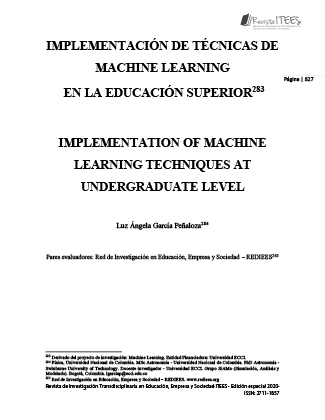XLIII. IMPLEMENTACIÓN DE TÉCNICAS DE MACHINE LEARNING EN LA EDUCACIÓN SUPERIOR
##plugins.themes.bootstrap3.article.main##
Resumo
A situação global causada pela COVID-19 nos levou a repensar nossos métodos de ensino. A educação superior não é estranha a esta transformação e, como resultado, professores e pesquisadores têm implementado novas técnicas e metodologias em nossos projetos. No campo da astronomia, os algoritmos de aprendizado de máquina estão ganhando cada vez mais força devido à sua versatilidade e alto poder de previsão, que resulta da implementação dessas técnicas em grandes conjuntos de dados. Há vários projetos que implementei com meus alunos: o primeiro explora o potencial das redes neurais para melhorar a estimativa de alguns parâmetros cosmológicos do modelo padrão ΛCDM. O segundo utiliza um algoritmo K significa que o K não supervisionado classifica
quasares (objetos muito luminosos e distantes), baseados em diferentes propriedades físicas observadas pelo SDSS (Sloan Digital Sky Survey) nas campanhas 12 e 14. A partir dos espectros de poderosos buracos negros em altos redshifts, e outras propriedades físicas detectadas pelo Sloan, geramos uma classificação de quasares com certas linhas de absorção.
O principal objetivo deste trabalho é mostrar o impacto da implementação de modernas técnicas de Aprendizagem de Máquinas em projetos de pesquisa com estudantes de engenharia e as perspectivas destes projetos em outras disciplinas.
Download Statistics
##plugins.themes.bootstrap3.article.details##
aprendizagem de máquinas, aprendizagem de máquinas, aprendizagem profunda, educação superior, redes neurais
https://openai.com/blog/ai-and-compute/. 2019.
M. Ntampaka, C. Avestru, et al. Astro2020 Science White Paper: The Role of Machine
Learning in the Next Decade of Cosmology, arXiv:1902.10159v1
S. Dodelson. Modern Cosmology, Academic Press, Elsevier Science, 2003
S. Ravanbakhs, J. Oliva, et al. Estimating Cosmological Parameters from the Dark Matter
Distribution, arXiv:1711.02033v1
S. Pan, M. Liu, et al. Cosmological Parameter Estimation From Large-scale Structure Deep
Learning, Aceptado en ApJ. arXiv:1908.10590v4
J. H. T. Yip, X. Zhang, et al. From Dark Matter to Galaxies with Convolutional Neural
Networks, Second Workshop on Machine Learning and the Physical Sciences
(NeurIPS 2019), arXiv:1910.07813v1.
Siyu He, Y. Li, et al. “Learning to Predict the Cosmological Structure Formation”, PNAS,
vol. 116, 28, 1–8, 2019.
J. Zamudio-Fernandez, A. Okan, et al. Higan: Cosmic Neutral Hydrogen With Generative
Adversarial Networks, arXiv:1904.12846v1.
E. Giusarma, M. R. Hurtado, et al. “Learning Neutrino Effects Cosmology With
Convolutional Neural Networks”, arXiv:1910.04255v1.
Z. Guo, P. Martini. Classification of Broad Absorption Line Quasars with a Convolutional
Neural Network. The Astrophysical Journal, vol 879, issue 2, 72, 12, 2019.
S. Skillman, M. Warren, M. Turk, et al. Dark Sky Simulations: Early Data Release.
arXiv:1407.2600.
M. S. Warren. 2HOT: An Improved Parallel Hashed Oct-Tree N-Body Algorithm for
Cosmological Simulation. arXiv:1310.4502.
L. A. García, E. Tescari, et al. Theoretical study of an LAE – CIV absorption pair at z = 5.7,
Monthly Notices of the Royal Astronomical Society: Letters, vol. 469, issue 1, pp.
L53-L57, 2017.
L. A. García, E. Tescari, et al. Simulated metal and HI absorption lines at the conclusion of
Reionization, Monthly Notices of the Royal Astronomical Society, vol. 470, issue 2,
pp. 2494-2509, 2017.
L. A. García, E. V. Ryan-Weber. Can UVB variations reconcile simulated quasar absorption
lines at high redshift? Revista Mexicana de Astronomía y Astrofísica, vol. 56, pp. 97-
111, 2020.
P. A. R. Ade et al. Planck 2015 results. XIII. Cosmological parameters, arXiv:1502.01589.
N. Aghanim et al. Planck 2018 results. VI. Cosmological parameters, arXiv:1807.06209.
Y. LeCun, L.D. Jackel, B. Boser, et al. Handwritten Digit Recognition: Applications of
Neural Net Chips and Automatic Learning. IEEE Communication, pp. 41-46, 1989.
D. E. Rumelhart, G. E. Hinton, J. L. McClelland. A general framework for parallel distributed
processing. vol 1: Foundations pp. 45–76, 1986.
L. Deng, D. Yu. Deep Learning: Methods and Applications. NOW Publishers, 2014.
I. Goodfellow, Y. Bengio, A. Courville. Deep Learning. MIT Press,
http://www.deeplearningbook.org, 2016.
D. Osinga. Deep Learning Cookbook: Practical Recipes to Get Started Quickly. O'Reilly
Media, Inc., 2018.
H. Fathivavsari. Deep Learning Prediction of Quasars Broad Ly alpha Emission Line.
arXiv:2006.05124v1
V. de Sainte Agathe, C. Balland, Hélion et al. Baryon acoustic oscillations at z = 2.34 from
the correlations of Ly alpha absorption in eBOSS DR14. Astronomy & Astrophysics,
629, A85, 2019





